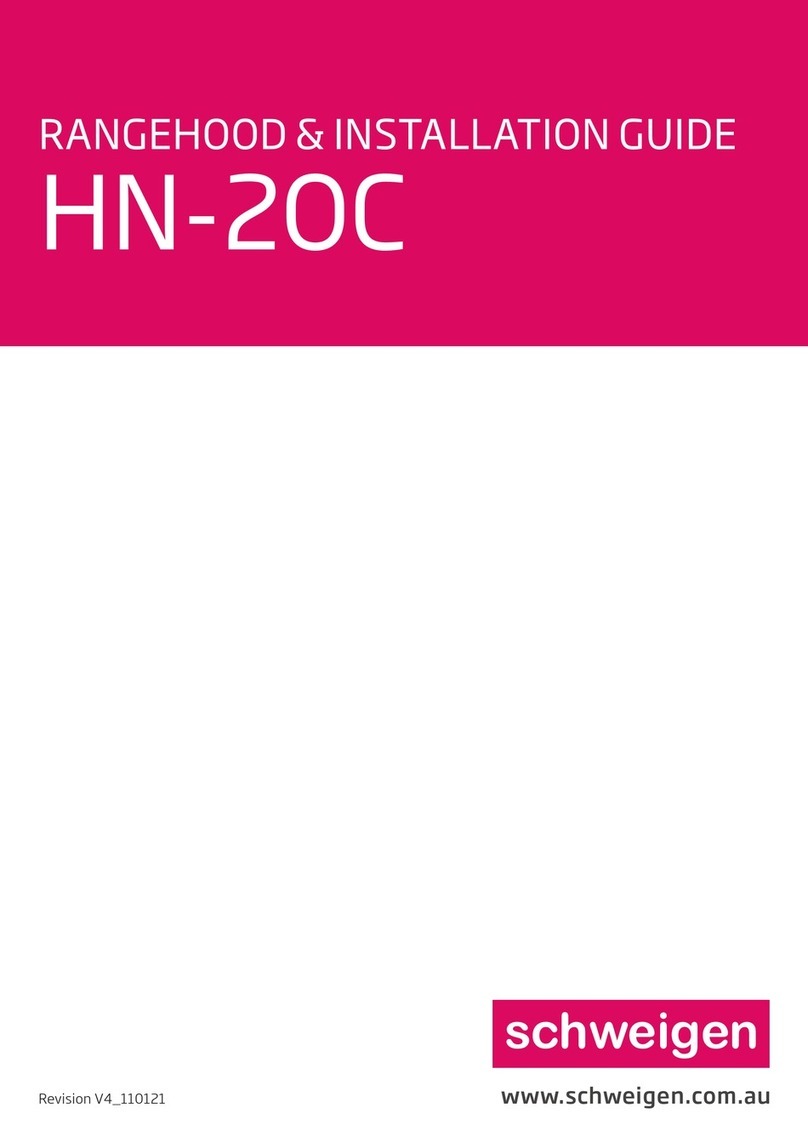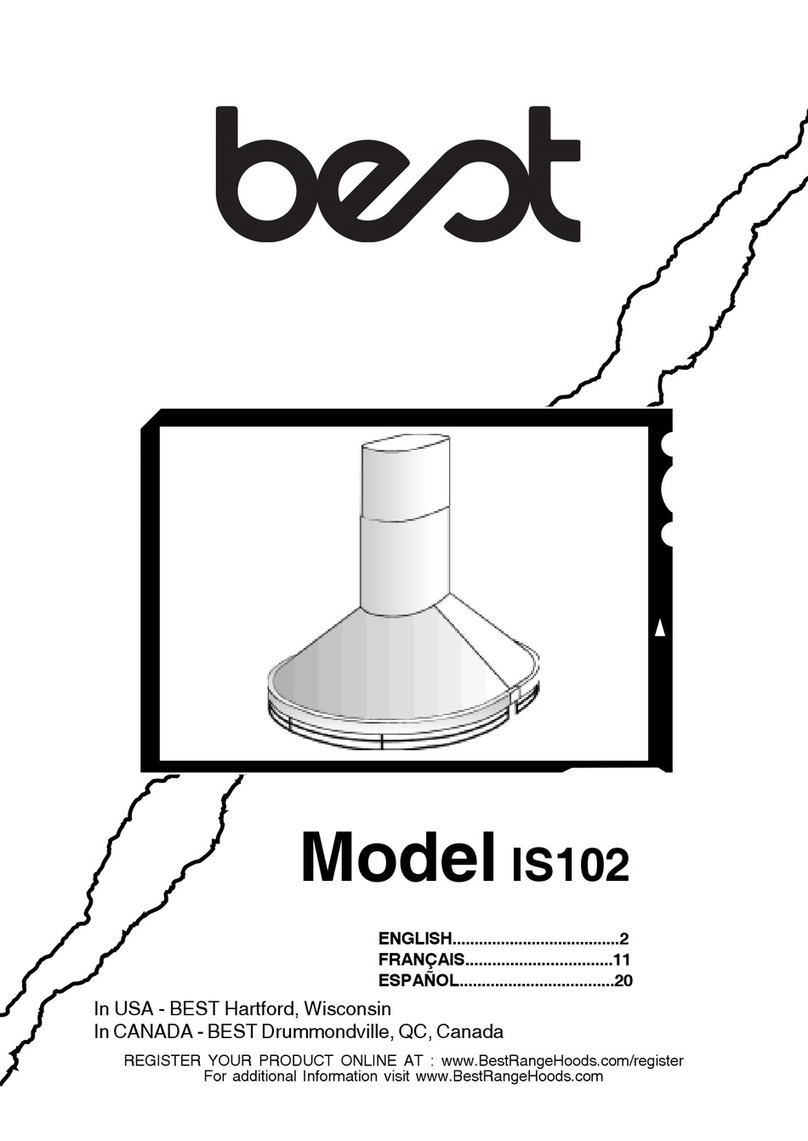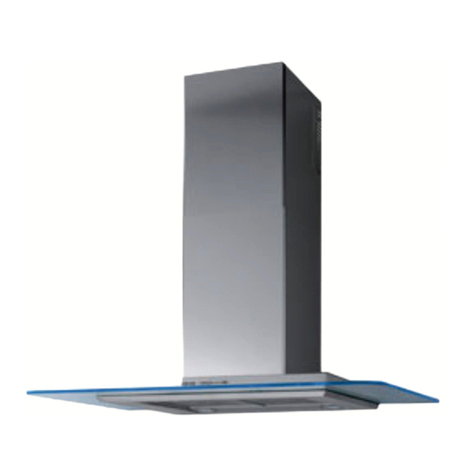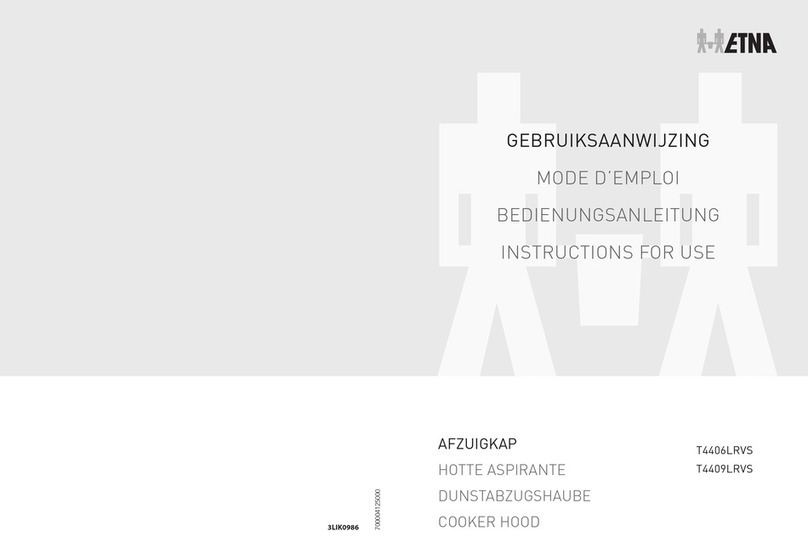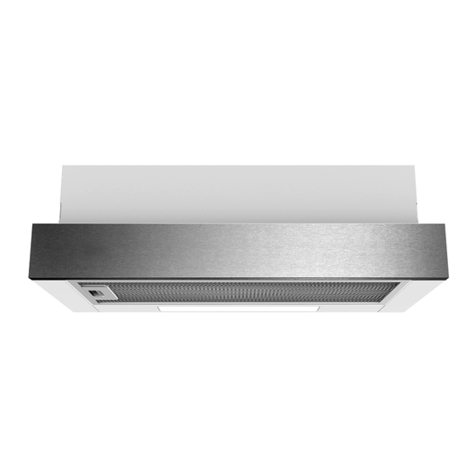Thor Kitchen HRH3001U Assembly instructions

HRH
Range Hood Installation Guide and User Manual
Applicable model: HRH3001U HRH3002U HRH3003U HRH3004U HRH3005U
HRH3601U HRH3602U HRH3603U HRH3604U HRH3605U
HRH4801U HRH4802U HRH4805U

Safety Notice
Approved for residential type untis for residential use only read these insructions and be safe.
Please read these instructions completely before starting.
The installation of the appliance must respect all codes.
Important: Save these instructions so that you can provide the electrical inspector in your area.
Safety Warning: Turn off the circuit in the electrical panel and lock front panel to connect the cord of this unit.
Power requirement: 110V-120V/60HZ
CAUTION: USE THIS PRODUCT FOR GENERAL FAN ONLY. DO NOT USE THIS PRODUCT TO EXHAUST FUMES OR
HAZARDOUS OR EXPLOSIVE MATERIALS.
WARNING TO REDUCE THE RISK OF FIRE, ELECTRICAL SHOCK OR INJURY TO PEOPLE, OBSERVE THE
FOLLOWING:
1. Use this unit only for the purposes intended by the manufacturer. If you have any questions about this product, contact the
manufacturer.
2. Before the machine’s maintenance or cleaning, turn off the electrical panel and lock the panel blocking feature to prevent
from accidentally activating the power. If it is not possible to lock the access panel, attach a highly visible label to the
electrical panel.
3. A qualified person should perform the installation and wiring of the electricity in accordance with all codes and all
standards, including fire resistance rating.
4. When you use hood together with stove, please do not close the window and door of the kitchen. Because during the fuel
stove working, which will consume lots of air, so do open the door and window to make the kitchen ventilating, to avoid
any suffocation.
5. It is important to provide sufficient air for proper combusion of heating equipment and proper evacuation of gases through
the chimney pipe to prevent back flow of air. Follow the instructions and safety standards of the manufacturers of heating
equipment, such as those published by the National Fire Protection Association (NFPA), the American Society for Heating,
Refrigeration and Air Conditioning Engineers (ASJRAE) and the code authorities in your area.
6. When cutting or drilling into wall or ceiling, be sure not to damage electrical wiring or other access to public service.
7. Always evacuate outside the conduit system.
To reduce the risk of fire and to properly exhaust air, be sure that the pipe is leading outside, do not exhaust air into the

space between the walls, ceilings, attics, crawl spaces or garages.
Waring: TO REDUCE THE RISK OF FIRE, USE ONLY METAL DUCT, Install this hood in accordance with all the
requirements mentioned.
WARNING: TO REDUCE THE RISK OF FIRE, GREASE THE RANGE.
1. Never leave the stove unattended when it is at a high temperature. Boil overs cause smoke and fat that overflows can
ignite. Heat the oil slowly at a low or medium temperature.
2. Always operate the hood when you use the stove to high heat or when you Flame.
3. Clean ventilating fans frequently. Do not let fat accumulate on the filters or propellers.
4. Use proper pan size. Always use a pot size appropriate to the stove element.
5. Do not touch on-working or off-soon bulb, to avoid any thorny.
Warning
TO AVOID INJURING SOMEONE IN A GREASE FIRE, FOLLOW THE FOLLOWING:
1. SMOTHER FLAMES with a lid to the dimensions of the cooking hobs, a cookie sheet or other metal tray, then turn off the
gas or power supply of the stove. BE CAREFUL NOT TO BURN YOURSELF. If the flames do not go out immediately, LEAVE
AND CALL THE FIRE DEPARTMENT.
2. NEVER PICK IP A FLAMMING PAN. You could be hurt.
3. DO NOT USE WATER, including Dish towels or wet towels-a violent steam explosion of dew may be occured.
4. Use an extinguisher only if:
. You are sure to have a Class ABC extinguisher that you know how to use.
. The fire is small and confined to the area where it was formed.
.Firefighters was called.
.You can fight against the fire with an exit behind you.
Operative Mode
Always leave safety grills and filers in place. Without the presence of lowers could catch hair, fingers or clothing. The
manufacturer is not liable if detailed in this manual for installation info, maintenance and proper use of the product are not
observed. The manufacturer declines all responsibility for any injury caused by negligence. This product is manufactured for
internal use. Do not use this appliance outdoors.

Electrical requirements and installation requirements
Power
Requirements
IMPORTANT
Observe all governing codes and ordinances. The customer is responsible for: Contacting an electrician-installer. Check that
the electrical installation is adequate and in conformance with the National Electrical Code, ANSI / NFPA 70 (latest edition *)
or CSA Standards C22.1-94, Canadian Electrical Code, Part 1 and C22.2 No.0-M91 (the latest edition **) of the CSA, and all
codes and ordinances in your area. If codes permit and use a wire to separate the ground, it is recommended to check the
path of the wire by an electrician. Do not put the device to land on a gas line. Consult a qualified person if you are not sure
that
the
hood
is
properly
grounded
electrically.
Do
not
install
a
fuse
in
the
neutral
circuit
or
circuit
ground.
Location of the electrical installation
• The cable must enter the rear wall at least 20 to 1/4 "above the height of the installation base, and between 7-5/8" and 4-7/8
"from the left side of the middle line.
MPORTANT
Keep these instructions in order to return them to the electrical inspector. The hood must be plugged directly into a 110 volt
wall outlet.
Before installing the hood
1.
To
ensure
the
most
efficient
ventilation
possible,
install
the
pipe
in
a
straight
line
or
with
the
least
elbows
possible.
CAUTION:
The output of the vent pipe should give to the outside.
2.
Two
people
are
required
for
installation.
3. Supplied hardware can secure the hood to most walls and ceilings, consult a qualified installer to ensure that the hardware
provided is suitable for your type of wall or cabinet.
4. In the case of areas prone to COLD WEATHER, install a check against extra-circulation to minimize the cold air return and
a nonmetallic thermal break to minimize conduction of outside temperature in the duct. The valve must be placed on the side
of
the
cold
air
from
the
heat
insulator.
The
insulation
must
be
placed
as
close
as
possible
to
where
the
pipe
enters
the
heated
part of the house.
5.
Air
booster:
The
building
code
in
your
area
may
require
the
use
of
a
make-up
air
system
if
you
use
a
ventilation
system
which leads the movement of air exceeding a certain number of CFM. The number of ft3/min varies from one region to
another. Consult your HVAC professional for specific requirements in your area.
Remove
the
packaging.
CAUTION
:
Carefully remove the cardboard, gloves to protect against sharp edges.

Examples and positioning possibilities ducts
Follow the letter of the guidelines presented in this manual.
The
manufacturer
declines
any
liability
with
respect
to
any
loss,
damage
or
fire
caused
by
non-observance
of
the
instructions
contained in this manual.
Ventilation methods
The hood is equipped with a vertical transition to remove fumes outside.
Recommended diameter conduit model and wall chimney hood and hood island: vertical round pipe 7'' tolerance + or – 1.
Models
Chimney
hood
Wall:
HRH3003U,
HRH3004U

Do not cut a joist or stud unless it is absolutely necessary to do so. If you need to cut a joist or stud, you must build a support
Framework, hardware supplied can secure the hood to most walls and ceilings. However, you should ask a qualified
technician to check the strength of materials depending on the type of wall or ceiling. Before cutting, make sure there is
enough clearance in the ceiling or wall for the outlet pass. You can determine for yourself how high you install the hood above
the stove. Over the hood near the stove, it is more effective to capture cooking odour, grease and smoke.

Clearance Training
Caution
:
When
install
the
hood,
the
height
should
not
be
too
high
or
too
low.
Before
the
installation,
please
inspect
the
maximum
height
of
your
ceiling
and
bonnet.Too
high,
will
affect
the
efficiency
of
the
hood;
too
low,
stove
temperature
will
damage
some
parts
of
the
hood.
So
the
installation
height
requirement
is:
the
distance
between
the
bottom
of
the
hood
to
the
surface
of
the
cooktop
is
Max
30
”
/
Min
27
”
(as
figure
showing)

Installation
If possible, unplug the stove and move it in order to have better access to the rear wall. Otherwise, place a thick blanket on
the counter and the cooking surface to protect it from damage and dirt. Select a flat surface for assembling the device.
Then put the debris of the cover and hardware on to the protective cap.
Determine
and
mark
the
center
line
on
the
wall
where
you
installed
the
canopy
hood.
Determine
a
comfortable
height
for
the
user
and
mark
it
on
the
wall
behind
the
stove
top.
Place the template on the center line and the bottom of the hood with adhesive tape.
Place
the
squares
of
the
flue
The
flue
must
be
installed
against
the
back
wall
and
the
ceiling.
This
bracket
will
keep
the
chimney
up
to
the
top.
Attach
the
brackets
to
the
wall:
•
Align
the
center
lines
drawn
on
the
bracket
with
the
center
lines
on
the
wall.
•
Identify
the
two
screw
holes
on
the
wall.
•
Drill
pilot
holes
5/16
"in
the
locations
shown.
•
Place
the
fastening
clips
to
the
wall.
•
Tighten
wood
screws,
by
hand,
in
the
attachments
to
allow
hooks
to
expand.
Remove
the
screws.
•Drill guide hole,¢5/16inch.
•Make clamp fix to the wall, screw down the bolts on the wall.
•
Attach
the
bracket
to
the
wall
using
the
screws
and
/
or
fasteners.
Ceiling
pipe
If
the
duct
vents
just
above
the
ceiling:
•
Use
a
level
to
draw
a
line,
the
center
line
of
the
template
to
the
ceiling.
•
Measure
at
least
4
"from
the
back
wall
to
the
center
of
the
circle
with
a
hole
7
-
½
"
in
the
ceiling.
Lead
in
the
wall
If
the
duct
vents
at
the
rear:
Note:
For
a
minimum
extension
of
the
chimney,
we
recommend
using
an
adapter
circular
/
rectangular
fireplace.
•
Use
a
level
to
draw
a
straight
line
from
the
center
line
on
the
template.
•
Measure
at
least
26
-
1/4
"(the
measure
may
vary
elbow
used)
above
the
pencil
line
indicating
the
height
of
the
bottom
of
the
system,
the
circle
of
a
conduit
hole
7
-
½
"in
diameter
(the
hole
may
be
enlarged
for
the
passage
of
the
elbow).

Necessary Tools


HRH3003U

Installation dimension figure of HRH3004U as below:


HRH3004U
Installation dimension figure of HRH3001U and HRH3002U as below:
Fix 6pcs screws( see figure 4) to the installation dead plate
Fix the installation dead plate to the wall by screws( see figure 5)
Use double-faced aluminum foil sealed-joint( see figure 6)
Power line color (black to black, white to white, green to green) (see figure 7)
Oil box of the hood (see figure 8)
Installation of clapboard filter screen (see figure 9)

Figure4 Figure5

HRH3001U HRH3002U


Description orders for model HRH3001U HRH3003U HRH3004U
Automatic activation control function of the sensor:
There are 5pcs sensor buttons,1pc remote control signal lamp(remote controller included), 2pcs stainless steel grease boxes,
2pcs stainless steel baffle filters and 2pcs led bulbs( 12V/1.5W).
A0 button: Remote control signal lamp
A1 button: Power( on/off)
A2 button: LED bulb
A3 button: Display screen
A4 button: Time Delay. A5 button: Low speed
A6 button: High speed
A4 button equip with Max 15 minutes after power off, A1 button( on/off) control to directly started or off.
Open The Fan
Keep your hood working during the cooking, and keep vantilating.
Press A1 button, then A3 display screen open.
Button A5 and A6 activates,high speed (F4),average speed(F3), low speed(F2), quiet speed(F1).
Control Panel Layout and Button Disposition
Close The Fan
Off time-delay function just could close the fan, not affected the lamplight setting.
15 minutes time-delay
When fan working, press A4 button, digital screen will blink several seconds, default setting is 1minute,after that, will shut off
automatically.
During fan working, if you need to adjust time-delay function,press A4 button one time, will blink for a few seconds, press A6

button to increase delay-time, set the figure timers as the time you want, max delay-time is 15 minutes.
If time-setting changes from A6 button to A5 button, during the process, speed changes,but does not affect count down.
Off immediately
Press A1 button two times, fan turn off immediately.
Bulb control
Press A2 button once, turn on the lights, and again to turn off.
Press A2 button or A4 button, then will not able to turn on LED light.
Warning: In case of any scald, do not touch LED light, unless hood is closed or cooled.
A0 button: same as above.
Remote sensor: A0 is the remote control.Remote sensor to receive infrared (IR) remote control signal.
HRH3002U operating instruction as following:
Function Button: LED light button F1 low speed F2 medium speed F3 high speed F4 time-delay/on-off F5
Light Button: Power on, press F1 button once, turn on the lights, and again to turn off.
Fan button: When need to open the hood, turn on the power, press F2 button ( low speed) F3 button (medium speed)
F4 button(high speed)
Time-delay Button: Power on, press any button of F2/F3/F4, fan starts and F5 light automatically but does not blink.
Press F5 again, time-delay function starts, when F5 indicator light starts to blink, time-delay function unadjustable,
default setting time is 5 minutes. Press F5 button again, time-delay and fan both close, LED light still on, which is independent
switch.

MAINTENANCE
WARNING
Before servicing or cleaning unit, switch power off at service panel and lock in access to prevent it being switched on
accidentally. If the power panel can not be locked, put a prominent warning device, such as a brightly coloured label.
Grease filters
The
grease
filters
should
be
cleaned
once
a
month
or
as
needed.
To
remove
grease
filter,
pull
the
metal
latch
down.
This
will
disengage
the
filter
hood.
Tilt
the
filter
down,
then
remove.
To
clean
the
filters,
use
a
solution
of
warm
water
and
detergent.
Let
them
dry,
then
reinstall.
The
metal
filters
are
dishwasher-safe.
Clean
filters
made
entirely
of
metal
in
the
dishwasher
using
a
non-phosphate
detergent.
Using
a
detergent
containing
phosphates
and
local
water
conditions
may
cause
discoloration
of
the
filters,
without
affecting
their
performance.
This
discoloration
is
not
covered
under
warranty.
Hood
Cleaning
Cleaning
stainless
steel:
how
to
keep
his
"lustrous
appearance"
and
help
prevent
corrosion.
What
to
do:
-
Wash
surfaces
regularly
with
a
cloth
or
a
clean
cloth
soaked
in
warm
water
and
mild
soap
or
dish
detergent.
-
Always
clean
in
the
direction
of
squall
lines
(direction
of
the
grain).
-
Always
rinse
well
with
clear
water
(2
or
3
times)
after
cleaning
and
dry
completely.
-
A
household
cleaner
designed
for
stainless
steel
can
also
be
used.
Don'ts:
-
Use
steel
wool
or
stainless
steel
or
any
other
scrapers
to
remove
stubborn
dirt.
-
Use
any
harsh
or
abrasive
cleansers.
-
Allow
dirt
to
accumulate.
-
Allow
the
plaster
dust
or
any
other
construction
residues
reach
the
hood.
Cover
the
hood
while
working
to
ensure
no
dust
hood.
To
avoid
when
choosing
a
detergent
-
Any
cleaners
that
contain
bleach,
because
they
attack
stainless
steel.
-
Any
product
containing
chloride,
fluoride,
iodide,
bromide,
they
quickly
deteriorate
surfaces.
-
Any
combustible
products
used
for
cleaning
such
as
acetone,
alcohol,
ether,
benzene,
etc.These
products
are
highly
explosive
and
should
never
be
used
near
a
stove.
To
replace
the
bulbs:
1.
Shut
off
the
power
2.
Take
off
the
grease
filters,
press
both
sides
of
the
elastic
clamps
on
the
bulb,
make
which
loose.
3.Gently
push
outward,
take
out
the
bulbs.
P.S:
If
necessary,
wear
gloves
when
taking
out
the
bulbs.
Other manuals for HRH3001U
2
This manual suits for next models
12
Table of contents
Other Thor Kitchen Ventilation Hood manuals
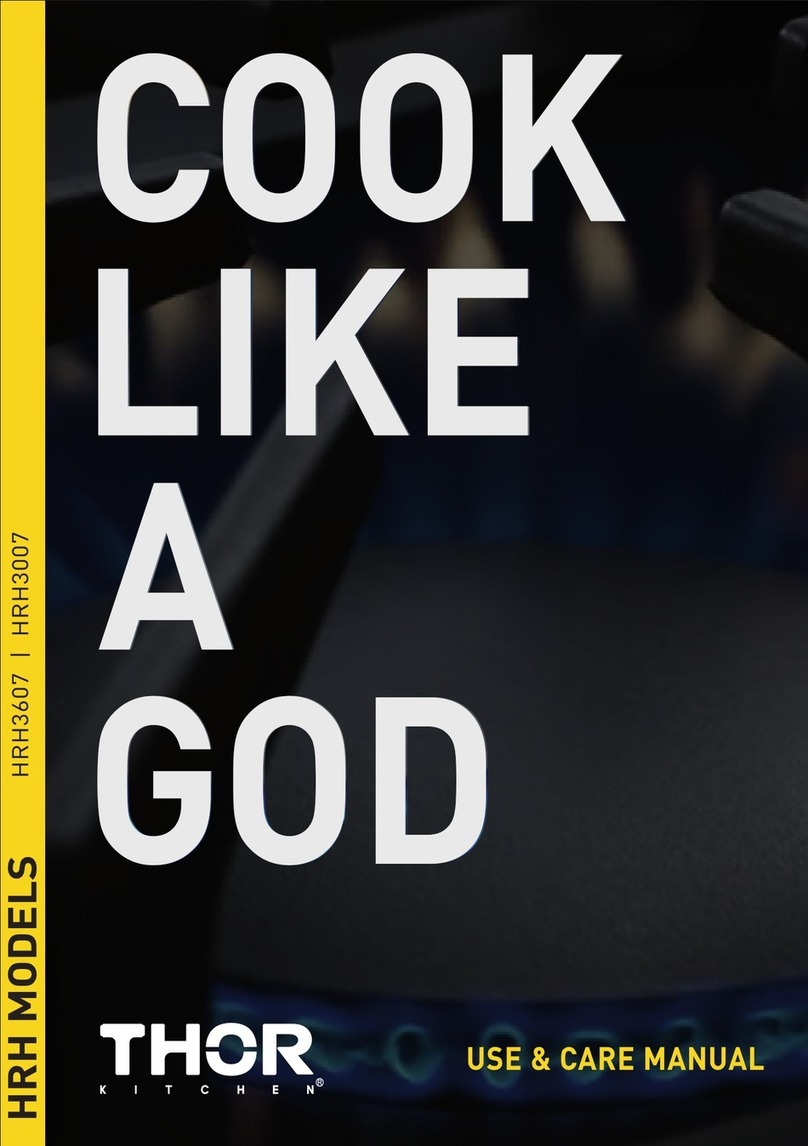
Thor Kitchen
Thor Kitchen HRH3607 User manual

Thor Kitchen
Thor Kitchen TRHP Series User manual

Thor Kitchen
Thor Kitchen HRH3001U Assembly instructions

Thor Kitchen
Thor Kitchen HRH3006-BS Assembly instructions

Thor Kitchen
Thor Kitchen TRHP User manual

Thor Kitchen
Thor Kitchen HRH3001U Assembly instructions
Popular Ventilation Hood manuals by other brands
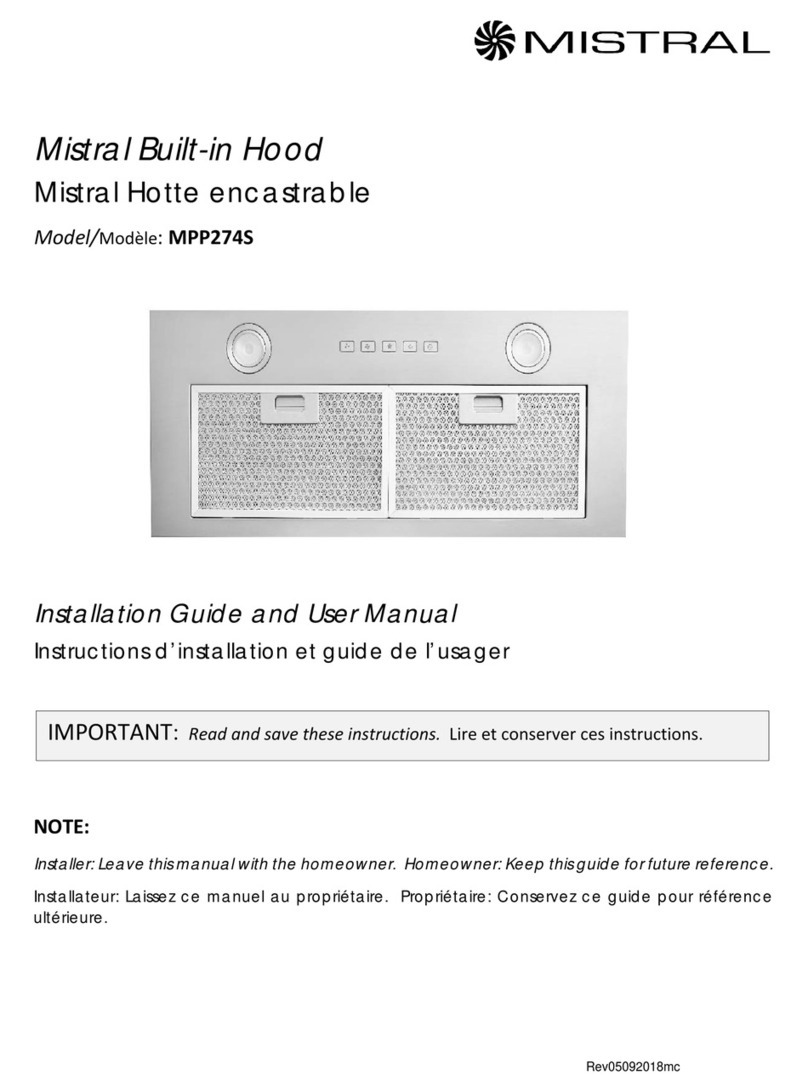
Mistral
Mistral MPP274S Installation guide and user's manual
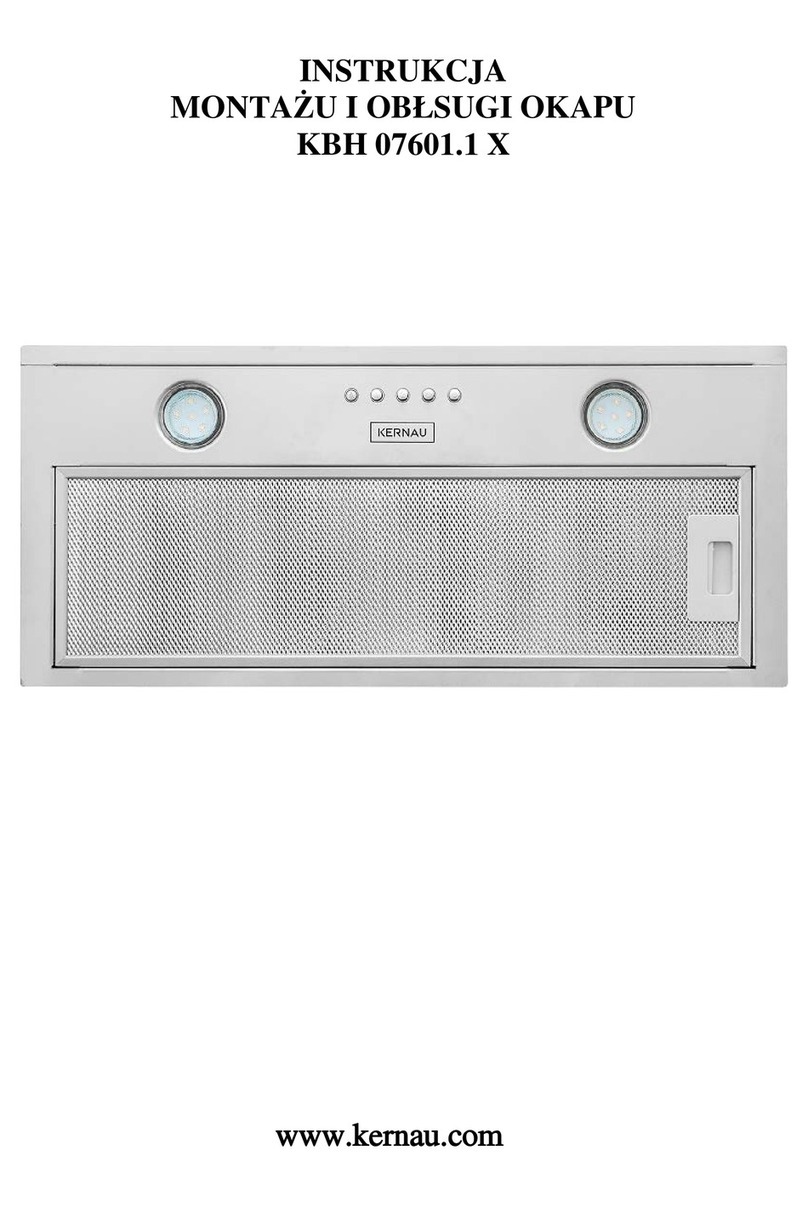
Kernau
Kernau KBH 07601.1 X Manual instruction
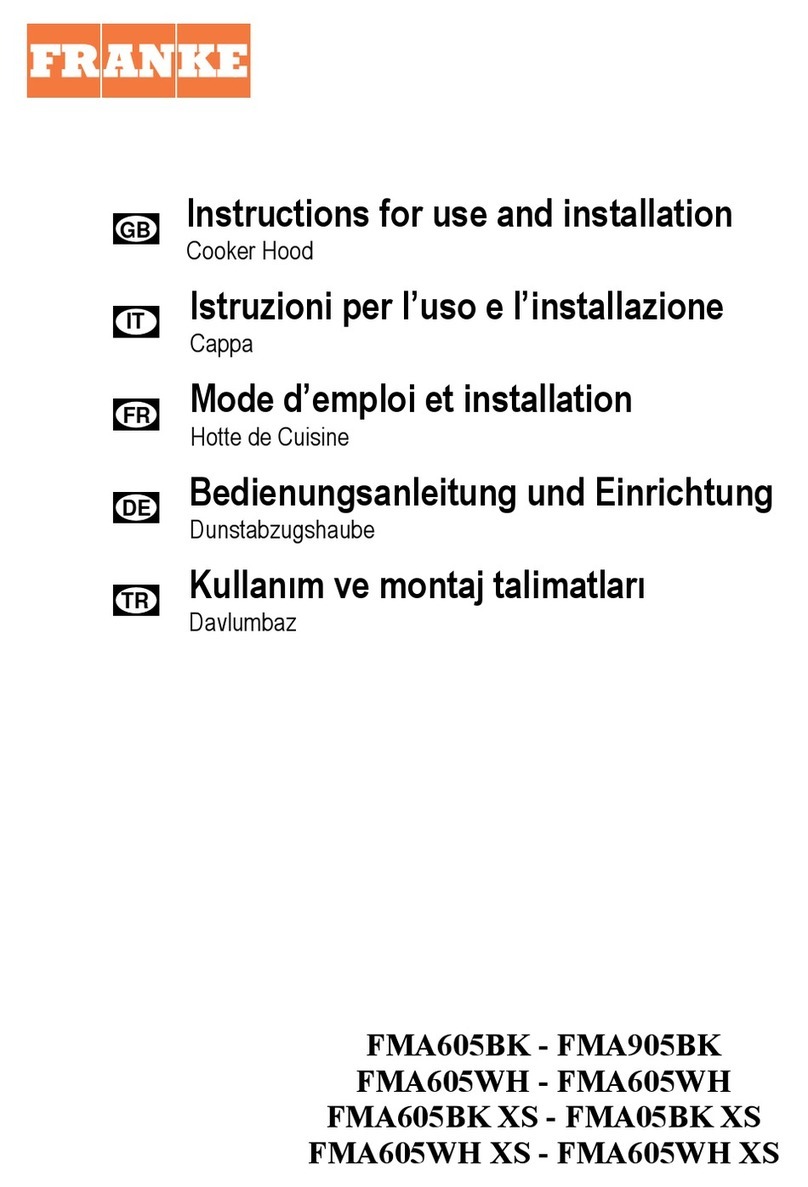
Franke
Franke FMA605BK Instructions for use and installation

ELICA
ELICA Om Series Instruction on mounting and use

Classique
Classique CLRH90XCLSS User manua

Gurari
Gurari PRIME GCH D 267 Manual for installation and use

